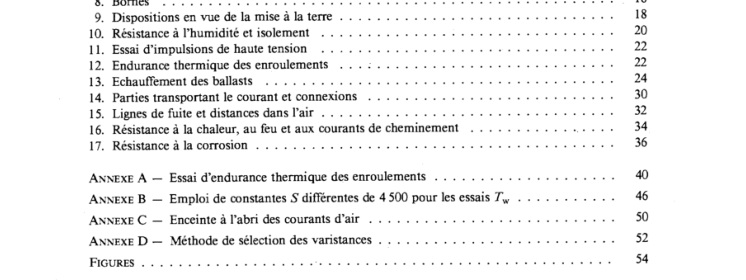CSA E922-98 pdf download – Ballasts for discharge lamps (excluding tubular fluorescent lamps) General and safety requirements.
10. Moisture resistance and insulation Ballasts shall be moisture-resistant and have adequate insulation. Compliance is checked by the tests of Sub-clauses 10.1, 10.2 and 10.3. 10.1 The ballast shall not show any appreciable damage after being subjected to the following test. The ballast is conditioned for 48 h in an enclosure containing air with a relative humidity main- tained between 91% and 95%. The temperature of the air at all places where samples can be located is maintained at 1 ‘C of any convenient value t between 20 ‘C and 30 ‘C. Before being placed in the enclosure, the sample is brought to a temperature between t and (t + 4) ‘C. 10.2 Insulation shall be adequate: a) between live parts of different polarity which are or can be separated; b) between live parts and external parts including fixing screws. Before the insulation test, visible drops of water are removed by means of blotting paper. Immediately after the moisture test, the insulation resistance is measured with a d.c. voltage of approximately 500 V, 1 mm after application of the voltage. Ballasts having an insulating cover or envelope are wrapped with metal foil. The insulation resistance shall be not less than 2 MQ. 10.3 Immediately after the measurement of the insulation resistance, the ballast shall withstand a di- electric strength test for 1 mm between the same parts as in Sub-clauses 10.2 a) and b). The test voltage of substantially sine waveform having a frequency of5O Hz or 60 Hz shall correspond to the values in Table 1. Initially not more than half the specIed voltage is applied, the voltage is then raised rapidly to the prescribed value.
11. High voltage impulse test Ballasts for metal halide lamps and ballasts for high-pressure sodium vapour lamps which are intended for circuits in which high voltage impulses occur on the ballast shall be subjected to the test either in Sub-clause 11.1 or 11.2 below. Ballasts designed for operating in a circuit with a starting device external to the lamp shall be subjected to the test in Sub-clause 11.1. Ballasts designed for operating lamps with an internal starting device shall be subjected to the test in Sub-clause 11.2. The manufacturer shall declare to which test his product has been subjected. 11.1 With a load capacitance of2O pF the six ballasts according to Sub-clause 4.3 are operated with the ignitor and the impulse voltage measured. The ignitor is then removed and the dielectric strength of components subjected to impulse voltage is then tested as follows: The ballast is operated with another similar ignitor at 1.1 times rated voltage without load capa- citance and without a lamp for a period of3O days. Should the ignitor break down before the 30 days have elapsed, it shall be replaced as often as a breakdown occurs until the test duration of3O days has been completed. Following this test, the voltage test in accordance with Clause 10 is carried out whereby the individual terminations, with the exception of the earthing conductor, are connected with each other. In doing so, no sparkover orflashover shall occur. The impulse voltage is then measured again with the original ignitor and the same load capacitance of2O pF. Deviation from the original value shall not be more than 10%. 11.2 From the six samples according to Sub- clause 4.3, three are subjected to the moisture resistance and dielectric strength test specified in Clause 10. The remaining three samples are heated in an oven until they attain the t,,, rating temperature marked on the ballast.
14. Current-carrying parts and connections 14.1 Electrical connections shall be so designed that contact pressure is not transmitted through insu- lating materials other than ceramic, pure mica or other material with characteristics no less suitable, unless there is sufficient resilience in the metallic parts to compensate for any possible shrinkage of the insulating material. Compliance is checked by inspection. 14.2 Spaced threaded screws shall not be used for the connection of current carrying parts, unless they clamp these parts directly in contact with each other and are provided with a suitable means of locking. Thread-cutting screws may be used for the interconnection of current-carrying parts which are not of metal that is soft or liable to creep, such as zinc or aluminium. Spaced threaded screws may be used to provide earth continuity, provided it is not necessary to disturb the connection in normal use and at least two screws are used for each connection. Compliance is checked by inspection. 14.3 Screws and rivets which serve as electrical as well as mechanical connections shall be locked against loosening. Spring washers may provide satisfactory locking. For rivets, a non-circular shank or an appro- priate notch may be sufficient. Sealing compound which softens on heating provides satisfactory locking only for screw connec- tions not subject to torsion in normal use.
CSA E922-98 pdf download.
